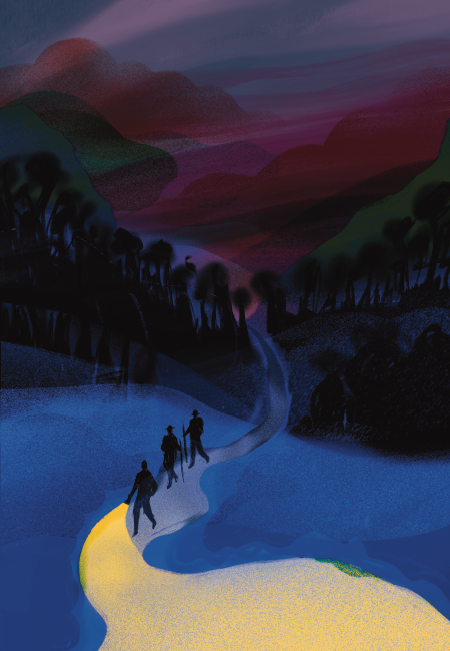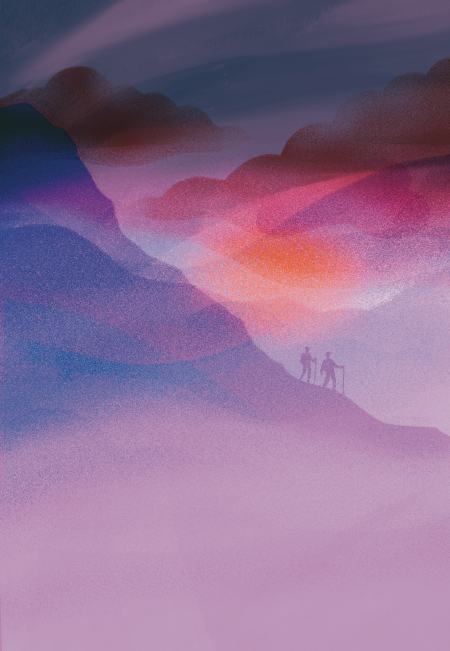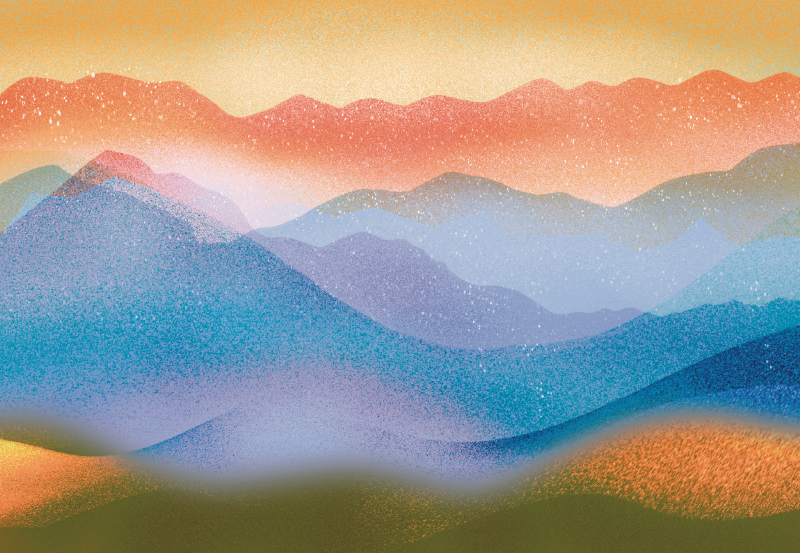Darkness has a way of revealing how lost we are, literally and metaphorically. Just when the fear settles that we may have strayed too far from the path, someone appears. That happened to me for the first time on a mountain.
The Triund trek in Himachal Pradesh is renowned for its breathtaking views of the Kangra Valley and the snow-capped Dhauladhar Range. It’s moderately difficult: a few hours up, a rewarding view at the top, and back to the plains by sundown. That was our plan.
In the summer of 2022, my husband and I embarked on this beautiful trek. After a scenic climb and a stunning view, we lingered a little too long on the summit before beginning the descent later than we should have. The mountains have a way of making time slip past unnoticed. The towering peaks cast long shadows, and the crisp mountain air filled our lungs. But as the sun dipped behind the ridges, the rhythm of the trail shifted. What was once peaceful became unfamiliar. The path blurred into darkness, and unease settled in. We heard the howls of animals, along with the buzzing of insects and the occasional slither of a snake.
By then, it was fully dark. We switched on our phone torches, only to find both batteries nearly drained. The trail was uneven, narrow, and becoming treacherous to follow.
I thought I saw something—a glimmer, like a pair of eyes glowing faintly from behind the trees. I didn’t want to assume. My heart palpitated. I blinked, and the glimmer was gone. Maybe I imagined it, I thought.
That moment opened something in me. A silent prayer arose. It was not for safety or help. It was beyond words. When all options run out, we do not ask for help, because help is logical. We ask for something beyond logic. We ask for a miracle. Though, as Spock from Star Trek might say, “There are no such things as miracles.”
But then, just like that, someone appeared.
“What are you guys doing here so late?” he asked, stepping toward us like he’d been there all along.
“We lost track of time,” my husband said. “And we may have lost the trail, too.”
He nodded, not surprised. “I’m a mountain guide. My group is camping at the summit. I’m heading down. You can come with me if you like.”

It was surreal. One moment, we were unsure. Next, the guide was there. Calm, steady, and completely at ease. His presence changed the atmosphere. My heart settled.
He walked with us for the next couple of hours, sharing stories of other treks and routes beyond Triund, like the Indrahar Pass. Eventually, we reached the base. A tea shop was still open, although it was late at night. We bought some water to pause and catch our breath. He asked where our car was, chatted briefly, and then quietly disappeared, with just a goodbye.
We hadn’t asked his name. We didn’t even remember how we’d addressed him. But I only remembered the moment of fear, the silent prayer, and the man who arrived just after.
When Guidance Becomes Presence
I think of this experience often. But I don’t want to reduce it to an interesting anecdote or story. It is too real. There was a sense of meaning that didn’t come from understanding, but from recognition, as if some part of me already knew this was not chance. It was a moment that transcended time and quietly became part of me. It didn’t belong to time, space, or any person.
The universe had responded to a signal I had sent out hours earlier. But what stayed with me was the realization that I had always been in touch. The universe didn’t have to respond, because how can something respond to itself? Would you respond to yourself?

It was a moment that transcended
time and quietly became part of
me. It didn’t belong to time, space,
or any person.
We often hear quotes like those from Rumi, who said, “You are the universe in ecstatic motion,” or from Kabir, who wrote of the drop that becomes the ocean when it merges with it. I once understood these as lofty spiritual metaphors. But in that moment, I recognized they were not just poetry. They pointed to something real. The universe is me. It didn’t have to respond. It simply revealed itself.
In my spiritual life, guidance has come through my father, mother, husband, mentors, and even through my son. And sometimes, through strangers, like this mountain guide. But in that moment, I felt that all of it was part of the same orchestration—a conversation, a communication, a communion from my Self to myself.
There’s a line in the book, Role of the Master in Human Evolution by Parthasarathi Rajagopalachari, that expresses it with simplicity:
“If there is one thing more important than truth, than spirituality itself, it is the Master who gives it to us.” —Vorauf, June 28, 1986
And this Master, this guiding force, is the universe itself, communicating through myriad ways. We often think of the spiritual guide as a revered figure who teaches, shares, and leads. But in Heartfulness, the guide is not merely a teacher or advisor. Their role goes deeper. It is an inner transmission, subtle, silent, and often unexplainable, that lights up something within. The guide doesn’t hand you a map. They help you discover your compass.
That night on the mountain, our guide, of course, pointed us to the path. But he also walked with us, trusted the trail, and invited us to do the same. That’s what a true spiritual guide does. Their help isn’t loud or obvious. Sometimes, it's a feeling of calm in confusion, or a shift in how you see something. A moment of quiet clarity. But it’s all more than that.
To receive that, we have to take the first step, often without knowing what comes next. Trust does not begin with certainty, but with willingness.
What stayed with me most was how the guide left. Without ceremony. Without asking for anything. And it reminds me again of the guide’s role. True gurus don’t create dependence. They walk beside us until we can walk on our own, and then quietly step back, revealing that they are part of our very own being.
Life, as the Master Intended
Spiritual journeys, like mountain treks, come with their own unique terrain: breathtaking views, steep climbs, valleys, and detours. Having a guide doesn’t mean we’re incapable. It means we walk with more grace and fewer stumbles. Over time, the outer guidance becomes something inward. The reassurance we first sought grows into inner strength. We begin to sense direction even when things are uncertain. True guidance transforms us rather than rescuing us. The guide shows us that life itself is the curriculum. Every moment, every silence, every uncertainty becomes part of the teaching.
And perhaps that is the guide’s true intention—not to shield us from difficulty, but through difficulty, to awaken something within us. The path isn’t laid out to be followed blindly, but rather, it is shaped step by step, according to our willingness to walk. In this way, life itself becomes both the teacher and the terrain. In Heartfulness, the guide is a presence of clarity and love that walks with you, showing you the light, until you realize that you are the light.
The guide’s true intention—not to
shield us from difficulty, but
through difficulty, to awaken something
within us.

When I first began meditating in my teenage years, I didn’t feel much. The teachings of Heartfulness were interesting and even inspiring, but I didn’t feel any earth-shattering transformation. Back then, I didn’t understand what I was receiving, or even what I was doing.
Later, when life’s terrain grew more complex, I began to understand. I recognized the gift that I had. I took refuge in the spiritual practice. We don’t look for guides on smooth roads or when we are admiring breathtaking views. We look for them when the trail vanishes, and when torch batteries run out.
The Heartfulness practice and the spiritual guide who offers it are both deceptively simple—no grand rituals and no promises. But with time, something inside begins to shift. Eventually, the path we once feared to walk in darkness becomes the one we tread, illuminated by light from within. Looking back, I see that the mountain guide belonged to that moment, emerging from the same darkness that had frightened me, appearing when I was ready to see him. That night, providence took the form of a stranger with a flashlight.
Illustrations by ANANYA PATEL

Purnima Ramakrishnan
Purnima is a UN award-winning writer and blogger. She is a fellow of Journalism by The International Reporting Project of the Johns Hopkins School of Advanced International Studies and the reci... Read More

